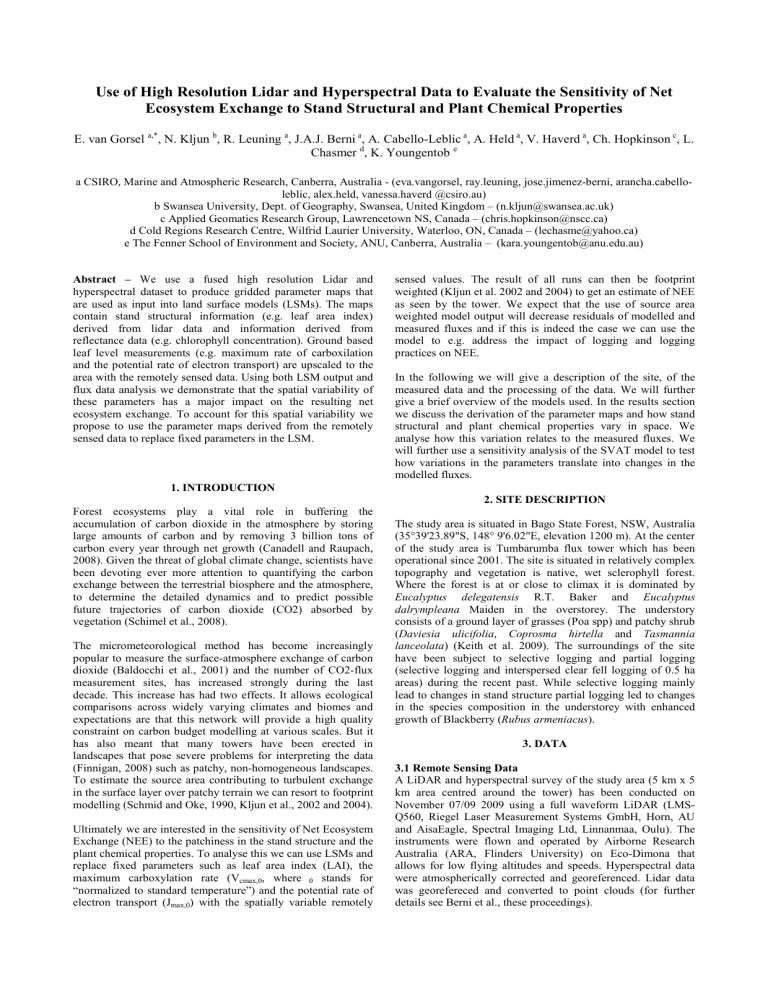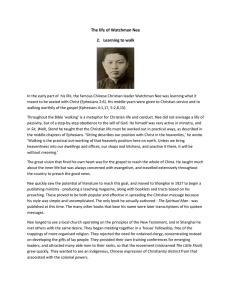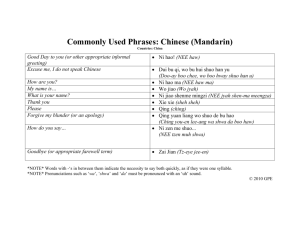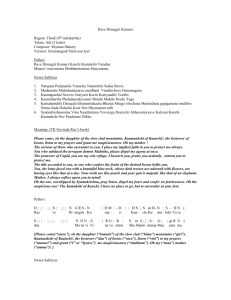Use of High Resolution Lidar and Hyperspectral Data to Evaluate... Ecosystem Exchange to Stand Structural and Plant Chemical Properties

Use of High Resolution Lidar and Hyperspectral Data to Evaluate the Sensitivity of Net
Ecosystem Exchange to Stand Structural and Plant Chemical Properties
E. van Gorsel
a,*
, N. Kljun
b
, R. Leuning
a
, J.A.J. Berni
a
, A. Cabello-Leblic
Chasmer
d
, K. Youngentob
e
a
, A. Held
a
, V. Haverd
a
, Ch. Hopkinson
c
, L.
a CSIRO, Marine and Atmospheric Research, Canberra, Australia - (eva.vangorsel, ray.leuning, jose.jimenez-berni, arancha.cabelloleblic, alex.held, vanessa.haverd @csiro.au) b Swansea University, Dept. of Geography, Swansea, United Kingdom – (n.kljun@swansea.ac.uk) c Applied Geomatics Research Group, Lawrencetown NS, Canada – (chris.hopkinson@nscc.ca) d Cold Regions Research Centre, Wilfrid Laurier University, Waterloo, ON, Canada – (lechasme@yahoo.ca) e The Fenner School of Environment and Society, ANU, Canberra, Australia – (kara.youngentob@anu.edu.au)
Abstract – We use a fused high resolution Lidar and hyperspectral dataset to produce gridded parameter maps that are used as input into land surface models (LSMs). The maps contain stand structural information (e.g. leaf area index) derived from lidar data and information derived from reflectance data (e.g. chlorophyll concentration). Ground based sensed values. The result of all runs can then be footprint weighted (Kljun et al. 2002 and 2004) to get an estimate of NEE as seen by the tower. We expect that the use of source area weighted model output will decrease residuals of modelled and measured fluxes and if this is indeed the case we can use the model to e.g. address the impact of logging and logging practices on NEE. leaf level measurements (e.g. maximum rate of carboxilation and the potential rate of electron transport) are upscaled to the area with the remotely sensed data. Using both LSM output and flux data analysis we demonstrate that the spatial variability of these parameters has a major impact on the resulting net ecosystem exchange. To account for this spatial variability we propose to use the parameter maps derived from the remotely sensed data to replace fixed parameters in the LSM.
1. INTRODUCTION
Forest ecosystems play a vital role in buffering the accumulation of carbon dioxide in the atmosphere by storing
In the following we will give a description of the site, of the measured data and the processing of the data. We will further give a brief overview of the models used. In the results section we discuss the derivation of the parameter maps and how stand structural and plant chemical properties vary in space. We analyse how this variation relates to the measured fluxes. We will further use a sensitivity analysis of the SVAT model to test how variations in the parameters translate into changes in the modelled fluxes.
2. SITE DESCRIPTION
The study area is situated in Bago State Forest, NSW, Australia large amounts of carbon and by removing 3 billion tons of carbon every year through net growth (Canadell and Raupach,
2008). Given the threat of global climate change, scientists have been devoting ever more attention to quantifying the carbon exchange between the terrestrial biosphere and the atmosphere, to determine the detailed dynamics and to predict possible future trajectories of carbon dioxide (CO2) absorbed by vegetation (Schimel et al., 2008).
The micrometeorological method has become increasingly popular to measure the surface-atmosphere exchange of carbon dioxide (Baldocchi et al., 2001) and the number of CO2-flux measurement sites, has increased strongly during the last decade. This increase has had two effects. It allows ecological comparisons across widely varying climates and biomes and expectations are that this network will provide a high quality constraint on carbon budget modelling at various scales. But it
(
(35°39'23.89"S, 148° 9'6.02"E, elevation 1200 m). At the center of the study area is Tumbarumba flux tower which has been operational since 2001. The site is situated in relatively complex topography and vegetation is native, wet sclerophyll forest.
Where the forest is at or close to climax it is dominated by
Eucalyptus dalrympleana lanceolata delegatensis
Daviesia ulicifolia ,
R.T. Baker
Coprosma hirtella and
and
Eucalyptus
Maiden in the overstorey. The understory consists of a ground layer of grasses (Poa spp) and patchy shrub
Tasmannia
) (Keith et al. 2009). The surroundings of the site have been subject to selective logging and partial logging
(selective logging and interspersed clear fell logging of 0.5 ha areas) during the recent past. While selective logging mainly lead to changes in stand structure partial logging led to changes in the species composition in the understorey with enhanced growth of Blackberry ( Rubus armeniacus ).
3. DATA
3.1 Remote Sensing Data
A LiDAR and hyperspectral survey of the study area (5 km x 5 has also meant that many towers have been erected in landscapes that pose severe problems for interpreting the data
(Finnigan, 2008) such as patchy, non-homogeneous landscapes.
To estimate the source area contributing to turbulent exchange in the surface layer over patchy terrain we can resort to footprint modelling (Schmid and Oke, 1990, Kljun et al., 2002 and 2004).
Ultimately we are interested in the sensitivity of Net Ecosystem
Exchange (NEE) to the patchiness in the stand structure and the plant chemical properties. To analyse this we can use LSMs and replace fixed parameters such as leaf area index (LAI), the maximum carboxylation rate (V cmax,0
, where
0
stands for
“normalized to standard temperature”) and the potential rate of electron transport (J max,0
) with the spatially variable remotely km area centred around the tower) has been conducted on
November 07/09 2009 using a full waveform LiDAR (LMS-
Q560, Riegel Laser Measurement Systems GmbH, Horn, AU and AisaEagle, Spectral Imaging Ltd, Linnanmaa, Oulu). The instruments were flown and operated by Airborne Research
Australia (ARA, Flinders University) on Eco-Dimona that allows for low flying altitudes and speeds. Hyperspectral data were atmospherically corrected and georeferenced. Lidar data was georefereced and converted to point clouds (for further details see Berni et al., these proceedings).
3.2 Hemispheric photography
Hemispheric photos were taken at 30 plots around the tower.
The plots are placed within a circular area with a 1 km radius, centred on the flux tower. At each location five photos were taken. One at a central point and one in 17.5 m distance towards N, E, S and W. The camera was mounted on a tripod with a gimbal in 1.4 m height. The camera used is a Nikon Coolpix 950 with a FC-E8 fisheye lens. The images were processed with CANEye V5.0 (Weiss et al,
2004). Photos were taken at dusk and dawn or under cloudy conditions where this was possible. Otherwise the sun was masked before analyses.”
3.2 Leaf level Data
Leaf gas exchange measurements were carried out with a Li-
Cor LI 6400 portable Photosynthesis Measuring System (Li-
Cor, Lincoln, NE) with attached light source
(6400-02 LED)
(Keith et al., 2009 and Medlyn et al., 2007). After measuring leaf gas exchange the leafs were harvested, and 5mm diameter discs were dissolved in dymethylformamide.
Chlorophyll a and b concentrations were later determined with a UV/VIS Spectrometer (Perkin Elmer Lambda 2) as described in Porra et al. (1989).
3.3 Ecosystem scale Flux Data
Ecosystem scale net ecosystem exchange was measured with the Eddy Covariance method. The vertical eddy flux of CO2 at a reference height of 70 m was measured using an ultrasonic anemometer thermometer (Type HS, Gill Instruments Ltd.,
Lymington, UK), and an open-path infrared gas analyzer
(IRGA) for CO2 and water vapour (Li7500, Li-Cor Inc.,
Lincoln, NE, USA). The CO2 profile needed to derive the rate of change in storage of CO2 in the layer below 70 m was measured at nine heights (0.5, 4.6, 10.2, 18.1, 26.3, 34.4, 42.6,
54.4 and 70.1 m) using a closed path IRGA (Li6262, Li-Cor
Inc.) and gas switching valves. Advection terms (iii) were not routinely measured but known to be an issue at night and negligible during the day (van Gorsel et. al., 2007 and 2008,
Leuning et al., 2008). We therefore use daytime values only for this study.
3.4 Drivers of Ecosystem scale Fluxes
Main drivers of net ecosystem exchange at Tumbarumba on an hourly scale are (van Gorsel et al. 2010) shortwave incoming radiation (CM3 (of CNR1), Kipp and Zonen, Delft, NL), soil temperature (Type K (RS-2194315) Thermocouples, Lab made) and vapour pressure deficit (50Y Vaisala, Helsinki, FI).
Ancillary measurements are described in Leuning et al. (2005).
4. MODELS
4.1 Land Surface Model
We use CABLE-SLI, the canopy, turbulence and radiation components of a land surface model called CABLE combined with a soil model called Soil-Litter-Iso. CABLE (Community
Atmosphere Biosphere Land Exchange model, (Wang et al., in press )) is a global land-surface model (LSM) to simulate the surface fluxes of CO2, latent and sensible heat for the ecosystem surrounding the Tumbarumba tower. CABLE combines a two-leaf, sun-shade canopy model developed by
Wang and Leuning (1998), a model for surface roughness and aerodynamic resistance developed by Raupach et al (1997). Due to its performance CABLE has been adopted as the Australian community LSM and is a key component of the Australian
Community Climate Earth System Simulator (ACCESS). Soil-
Litter-Iso is a one dimensional model for coupled transport of heat, water and stable isotopes in soil with a litter layer and root extraction (Haverd and Cuntz, 2010).
4.2 Radiative transfer models
Radiative transfer at the foliage level is characterized by
PROSPECT (Jacquemoud et al., 1996) which provides the foliage optical properties as a function of the biochemistry.
PROSPECT was coupled to FLIGHT, the canopy radiative transfer model (North, 1996). FLIGHT is a three-dimensional ray-tracing model that uses Monte Carlo techniques for the radiative transfer within crown boundaries and deterministic ray tracing between the crowns and other canopy components. The canopy structure is represented by geometric primitives defined by crown shape and size, tree height, position, and distribution.
Average tree density and crown dimensions were extracted from
LiDAR data (see Berni et al, these proceedings)
5. RESULTS
5.1 Site Heterogeneity
Fractional Cover and LAI
Fractional cover (fcover) of the study area was calculated by classifying the LiDAR point returns into high and low vegetation or bare soil and account for the fraction of each component at each grid cell. We have analysed the relationship between fcover and LAI from hemispheric photography and used this relationship to scale LAI to the area. Figure 1 shows that LAI varies quite strongly throughout the study area. In particular we find that the area to the NE where partial logging has occurred only recently (during the past 3 years) is very patchy. The area to the SW has last been selectively logged in
2004 and the impact on LAI is clearly visible. The sector from
W to N is relatively undisturbed (last thinning occurred in
1991). Winds from the W of the tower dominate the flux measurements in the study period (Oct-Dec 2009).
Fig. 1: Leaf area index in the area of 5 km x 5 km centred around the flux tower. Black and white values indicate minimum and maximum respectively. For practical purposes the data was resampled to a spatial resolution of 25x25m.
Chlorophyll Content and Maximum Rate of Carboxylation
Average leaf concentration of Chlorophyll a+b
(Ch a+b
) was determined by using the ratio of the wavebands 750 and 710 nm
(Zarco-Tejada et al, 2001) and the LAI estimates. The radiative transfer models PROSPECT and FLIGHT were used to simulate a range of Ch a+b
and LAI values (Berni et al., these proceedings). The average spectrum was then used to determine
an equation of the form Ch a+b
=f(ρ750/ρ710,LAI), with an
RMSE between simulated and predicted Ch a+b
of 1.31µg cm
-2
.
In the relatively undisturbed parts of the forest Ch a+b concentrations range between 25 and 50 µg cm
-2
which corresponds well to leaf level measurements that cover the same range (Figure 2a).In the relatively undisturbed parts of the forest the absolute Ch a+b
concentrations range between 25 and
50 µg cm
-2 which corresponds well to leaf level measurements that cover the same range (Figure 2a).
CABLE-SLI for the Tumbarumba site using the observed ranges of these parameters. Figure 3a shows that over the range of observed LAI the system actually switches from being a net carbon source to a rather strong carbon sink. The sensitivity to the observed range of V cmax,0
is somewhat smaller but still leads to variations in NEE of a factor 2.
The photosynthetic capacity of leaves is linearly related to the nitrogen content and to a first approximation to the chlorophyll content of the leaves. We use this relationship, derived from leaf level measurements, to scale from Chl a+b
to V cmax,0 shown in Figure 2b ranges from 60 to 90 µmol m
. V
-2
s cmax,0
-1 in the undisturbed parts of the forest. It drops to about 90 µmol m
-2
as
s
-1
, where shrub is more dominating, to very low values where logging has occurred and re-growth predominantly consists of grasses.
5.2 Model sensitivity
We have investigated qualitatively how the spatial variability in
LAI and V cmax,0
translates into changes in NEE by running
5.3 Dependence of measured NEE on wind direction
Given the spatial variability of LAI and V cmax,0
and the sensitivity of NEE towards these parameters we would expect to observe a dependence of NEE on the wind direction. Figure 4 shows the frequency distribution of wind speed observed during three month, surrounding the time of the airborne survey (Oct-
Dec, 2009). The observed wind directions were predominantly from the western sectors. Winds from SW were more frequently related to positive residuals (measured –NEE derived from light response curve) (weaker carbon uptake), while winds from the
NW were more frequently related to positive residuals (stronger carbon uptake). The on average weaker (stronger) carbon sink in the SW (NW) sector is also confirmed by plotting NEE versus above canopy incoming shortwave radiation (R sw ↓
).
Northern and southern sectors clearly respond differently to
R sw ↓
, the primary driver of NEE with stronger carbon uptake in the northern sector.
6. CONCLUSIONS AND OUTLOOK
We have shown that both stand structural and plant chemical properties strongly impact on Net Ecosystem Exchange (NEE).
The observed LAI values in the study area correspond, on a larger scale, to ecosystems that vary from a net carbon source to
Fig. 4: Left: frequency distribution of wind direction and associated deviations of measured NEE from NEE derived from a light response curve (lrc) over the period Oct-Dec 2009.
Right: average lrc (green line) measured values from sector S to
W (red) and W to N (blue). Red values (left and right) indicate a lower than average carbon uptake by the vegetation. a rather strong carbon sinks. The sensitivity to the observed range of maximum carboxylation rates V cmax,0
is smaller but still leads to variations in NEE of a factor 2. Measurements of NEE at a central tower confirm that the variations in NEE originating from source areas with different LAI and V cmax,0
are strong enough to be detected. We hypothesise that using the parameter maps which reflect the spatial variability, rather than a single parameter value as input into the land surface model, will allow to more realistically model NEE. The footprint weighted modelled NEE can be verified with flux measurements. This methodology gives a framework to evaluate the sensitivity of
NEE to stand structural and plant chemical properties.
ACKNOWLEDGEMENTS
This work was supported by the Australian Greenhouse Office through the Australian Climate Change Science Program.
We thank State Forests of NSW for permission to install experimental equipment in Bago Maragle State Forests. We also acknowledge contributions to this work by Gael Picoulet, Jenny
Lovell, David Jupp, David Colville. Many thanks go to Shakti and Jorg Hacker for airborne data acquisition and processing support.
REFERENCES
Berni, J. A.J., N. Kljun, E. van Gorsel, V. Haverd, R. Leuning, A.
Cabello-Leblic, A. Held, Ch. Hopkinson and L. Chasmer, “3D spatial distribution of biophysical parameters derived from hyperspectral and lidar remote sensing. Improving the constraints in land surface modelling.” 34th ISRSE, Sydney,10-15 April 2011.
Canadell, P. and M. Raupach. “Managing forests for climate change mitigation.” Science 320, 1456–1457, doi:10.1126/ science.1155458. , 2008.
Finnigan, J.J., 2008. “An introduction to flux measurements in difficult conditions.” Ecol. Applic. 18, 1340–1350, 2008.
Jacquemoud, S., S. L. Ustin, J. Verdebout, G. Schmuck, G.
Andreoli and B. Hosgood, B. “Estimating leaf biochemistry using the PROSPECT leaf optical properties model.” Remote Sensing of
Environment, 56(3), 194–202, 1996.
Keith H., R. Leuning, K.L. Jacobsen, H.A. Cleugh, E. van Gorsel,
R.J. Raison, B.E. Medlyn, A. Winters and C. Keitel, “Multiple measurements constrain estimates of net carbon exchange by a
Eucalyptus forest” Agric.For.Meteorol.,149, 535-558, 2009.
Kljun, N., P. Calanca, M.W. Rotach, and H.P. Schmid, 2004: “A
Simple Parameterisation for Flux Footprint Predictions.” Boundary-
Layer Meteorol. 112, 503-523, 2004.
Kljun, N., Rotach, M. W., and Schmid, H. P. “A 3D Backward
Lagrangian Footprint Model for a Wide Range of Boundary Layer
Stratifications”, Boundary-Layer Meteorol. 103, 205–226, 2002.
Medlyn B.E., D. Pepper, A.P. O’Grady and H. Keith,” Linking leaf and tree water use with an individual tree model”, Tree Physiol. 27,
1687–1699, 2007.
Leuning R., S.J. Zegelin, K. Jones, H. Keith and D. Hughes,
”Measurement of horizontal and vertical advection of CO2 within a forest canopy.” Agric.For.Meteorol., 148, 1777–1797, 2008.
North, P. R. J., “Three-dimensional forest light interaction model using a Monte Carlo method.” IEEE Transactions on Geoscience and Remote Sensing, 34(4), 946– 956, 1996.
Raupach M.R., K. Finkele and L. Zhang, “SCAM (Soil-Canopy-
Atmosphere Model): description and comparison with field data.”
CSIRO Centre for Env. Mechanics technical report 132, 1997.
Schimel, D., M. Aubine and J. Finnigan, J., “Flux measurements in difficult conditions.” Ecol. Appl. 18, 1338–1339, 2008.
Schmid, H.P. and T.R. Oke, “A model to estimate the source area contributing to turbulent exchange in the surface layer over patchy terrain” Q. J. R. Meteorol. Soc., 116, pp. 965-988, 1990. van Gorsel E., R. Leuning, H.A. Cleugh, H., Keith, M.U.F.
Kirschbaum, T. Suni, “Application of an alternative method to derive reliable estimates of nighttime respiration from eddy covariance measurements in moderately complex topography.”
Agric. For. Meteorol. 148, 1174–1180, 2008. van Gorsel E., R. Leuning, H.A. Cleugh, H. Keith and T. Suni,
”Nocturnal carbon efflux: reconciliation of eddy covariance and chamber measurements using an alternative to the u*-threshold filtering technique.” Tellus 59B, 397–403, 2007.
Wang Y.-P., E. Kowalczyk, R. Leuning, G. Abramowitz, M.
Raupach, B. Pak, E. van Gorsel and A. Luhar, “Diagnosing errors in a land surface model (CABLE) in the time and frequency domains.” J. Geophys. Res., doi:10.1029/2010JG001385, in press.
Wang Y.P. and R. Leuning, “A two-leaf model for canopy conductance, photosynthesis and partitioning of available energy I: model description and comparison with a multi-layered model.”
Agricultural and Forest Meteorology, 91, 835 89-111, 1998.
Weiss M., F. Baret, G.J. Smith, I. Jonckheere and B. Coppin,
“Review of methods for in situ leaf area index (LAI) determination
Part II. Estimation of LAI, errors, and sampling.” Agricultural and
Forest Meteorology 121: 37-53, 2004.
Zarco-Tejada, P.J., J.R. Miller, G.H. Mohammed, T.L. Noland,
P.H. Sampson, “Scaling-up and Model Inversion methods with narrow-band Optical Indices for Chlorophyll Content Estimation in closed Forest Canopies with Hyperspectral Data.” IEEE
Transactions on Geoscience and Remote Sensing, 39(7), 1491-
1507, 2001





